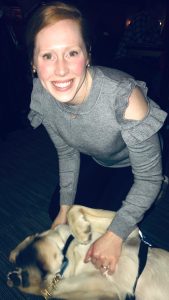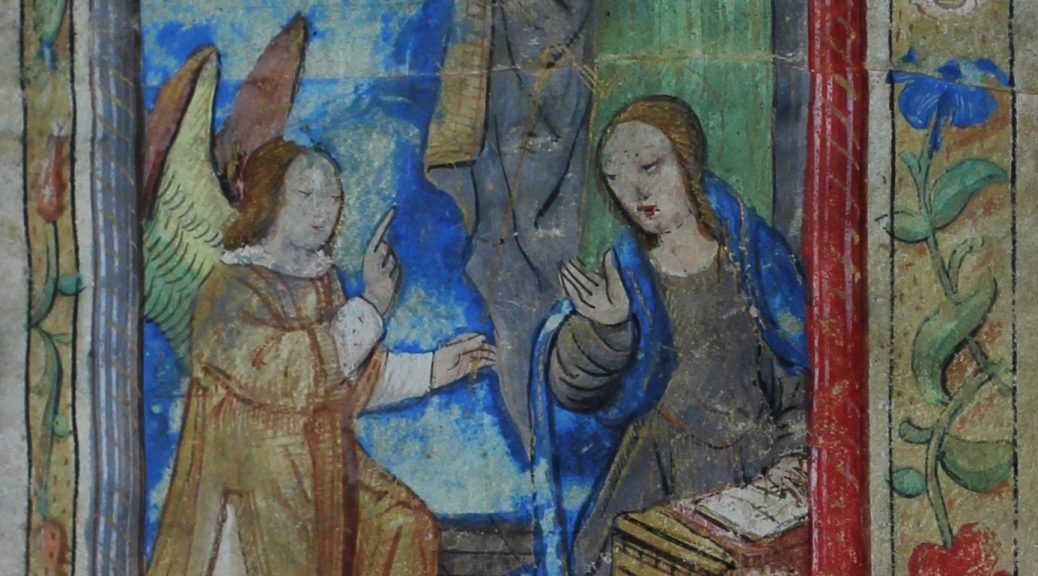Sometimes a single item in the archives can be the basis for an extended student project. This is how Kathleen Dusseault at Truman State University found herself creating a web version of a medieval book of hours in the library’s special collections. Dusseault worked with mentors Dr. Jon Beck (computer science) and Amanda Langendoerfer (library). Drawing on translations created by a former Truman student, Lauren Milburn, Dusseault designed and created a permanent addition to the library’s website. CURAH tracked down both Kathleen and Lauren and asked them about their work.
CURAH:How did you get involved with the project?

KD: I became involved with the project due to a frequent exposure to the materials located in Truman State University’s Special Collections and Museums Department from a couple of different art history courses. As I continued to pursue a degree in Art History I needed to complete an internship that involved elements of art history in some way. I also started working in Special Collections starting in the fall of 2017, and over the course of that year I reflected on what I could do for an internship. In the spring of 2018 I took a week long digital humanities class that taught the students some html and worked as a class to develop online resources that helped make something more interactive or easier to use. My group worked on making a site that would allow for students to see all the art prints that can be checked out visually instead of having a list of artist and title. While I did not work on the coding for that website, I found myself interested in developing something that would be useful for future students and others while at the same time working on a new skill.
This brings me to the project itself. I knew that I wanted to create a website (something that I had never done before), but I wasn’t sure on what precisely or where. I brought the idea up with the head of Special Collections and Museums, Amanda Langendoerfer, and she suggested several different books or exhibits that would work well for such a project. I was drawn to our one Book of Hours because of my previous interactions with the manuscript due to my art history classes and the work that former student Lauren Milburn had completed on it.
LM: As I was pursing my Classics degree, I developed an interest in sacred religious texts. When it came time for me to complete my

Capstone, my Classics department mentors suggested that I examine The Book of Hours in Truman’s Special Collections. After an initial examination of the manuscript we decided that transcribing and translating the text would be a challenging endeavor that would benefit future students. At the time having a digital copy of the manuscript was a long-term goal. Kathleen’s dedication and hard work made this dream a beautiful reality.
CURAH: What exactly was your part in the creation of the website?
KD: Years earlier the scans of the manuscript were taken in TIF format (for preservation) and a JPEG format (for uploading digitally) excluding certain blank pages. One of my goals, however, was to have the book be viewable outside of Special Collections just the way that it would be seen within, except digitally. With the help of Annie Moots (the Special Collections digital librarian) I got to scan the original pages that were missing (all of which were just blank pages not included in the original scan). I inputted all the JPEGs into a plugin called 3D FlipBook which accomplished this goal. I then researched Books of Hours in order to add content to several pages. I placed all content onto the WordPress site myself. The only other thing that I was not a part of was the translations by Lauren Milburn. In order to create that portion of the website labeled as Translation and Transcription I added the already written content myself but kept the way that Lauren formatted the writing (for her capstone). Originally, however, they were two separate text documents. The biggest change I made was placing the transcription on the left, the corresponding scan of the manuscript, and the translation on the right.
LM: For my Capstone project, I transcribed and translated the Latin within the manuscript. In addition, I deciphered and indexed abbreviations, decoded the format of the text, and created footnotes to provide context for the readers.
CURAH: What were the easiest and hardest things about the work you did?
KD: The easiest part to this project was adding content to the website. After looking at several books on the subject I found it easy to narrow a focus down on what sort of information I wanted to provide. I also had a lot of fun at the end of my project doing some user testing with library staff and friends who volunteered. I found that as I went along with the project I knew where to click to find certain information and it didn’t seem to work the same way with those who tested out the site at the end.
The hardest part that I had was working with Lauren Milburn’s transcription and translations. I was unfamiliar with the structure of quires (which is how Ms. Milburn had divided the content of her translation and transcription). In order to accomplish the task of putting the work online I first needed to understand how she had created the translation and transcription. Once I became more familiar with her work this was no longer an issue.
Formatting was another thing I struggled with on occasion. This was due to my lack of experience with WordPress, but after working on a couple of different pages and developing pages with a website builder plugin called Elementor I wasn’t finding this to be as much of an issue.
LM: The easiest part of working on this project was engaging with the subject matter itself. As a Roman Catholic I found translating the familiar prayers and sections of scripture exceptionally enriching. It also felt incredibly humbling to connect with a text that was a sacred source of meditation and prayer for the original owners. The hardest part of working with the text was deciphering the abbreviations and learning the writer’s Latin shorthand. Certain phrases and words were often shortened within the text because the prayer or piece of scripture had been stated in–full earlier within the Quire.
CURAH: What kinds of things did you learn?
KD: There are many different things that I learned while working on this project. As I only had a beginners knowledge on what a Book of Hours is and its purpose there was a lot of content that I learned in order to make the website. I also learned a significant amount about how to work with WordPress, which I think will be beneficial later on in life, and I learned quite a few things about myself. At the beginning there were three goals for my project. I wanted to make the Book of Hours visible outside of the reading room at Truman State, have the transcription side by side with original pages, and add the additional content for those who would like to learn more about such a manuscript. It’s from gathering this content and presenting it that I learned more about myself, surprisingly. I found that altering my perspective on the information was difficult for me. What I mean by this is that having even the slightest knowledge on the subject had me skipping over important pieces of information that would be necessary to people just learning about what is a Book of Hours. I found myself constantly looking over the information to find these gaps and sometimes completely missing them. To combat this I had users that volunteered to test out the site and read the content within it to find these spots where I may have missed crucial information. Watching users read the content and listening to their questions also let me know where information should be located or added. Due to this project I also thought more about future careers and potentially going into the field of museum registrar or an education route (such as history or museum).
LM: This project enabled me to learn about the process of creating Books of Hours and their accompanying illuminations. In addition, I learned how to carefully work with and handle the fragile vellum. In doing so, I was able to honor the past while working to provide a resource for students in the present.
CURAH: Did you make any discoveries along the way?
KD: This kinda relates back to what I learned, I probably wouldn’t say that I learned anything earth shattering about the Book of Hours that I worked with, but I did learn a lot about myself. I really enjoyed creating educational content that can be used by a variety of different people (i.e. researchers, students, faculty, scholars, anyone really). I also note in the site that within the border design on two of the illuminations have a particular flower in the border. That was an interesting tidbit that felt a little bit like a discovery to me.
LM: One fascinating aspect of working with this text was coming into contact with little French notes written in in the margins and in the back of the manuscript. Discovering these notes written by the owners made this project magical. The process of analyzingthe illuminations was another intriguing facet of this experience. Particularly, in regards to the ways in which ritual played a part in the owners’ mediations. For example, there is an illumination in which the face of Mary (the mother of Christ) has been “rubbed” away. I learned through this process that the owners must have repeatedly touched the illumination in this spot as they were praying.
Finally, the greatest discovery I made while completing this culminating project was the immense value in studying Classical languages. The time I spent studying Latin, Greek, and working on this Capstone project at Truman shaped who I am as a human and teacher. I am currently finishing a graduate degree in Applied Behavior Analysis and I still utilize the tools I cultivated as a Classics student every day. Specifically, this project and field of study enabled me to develop problem solving skills and the ability to analyze complex texts. I am extremely fortunate to have had the opportunity to learn from all of the professors in Truman’s Classics department and to have had their mentorship throughout this project. The trajectory of my life and career has been profoundly impacted by their support and knowledge. I am also exceedingly grateful to Kathleen and her dedication to digitally preserving this manuscript. She has done such stunning work and has given an amazing gift to our university.
![]()
This work is licensed under a Creative Commons Attribution-NonCommercial-ShareAlike 4.0 International License

